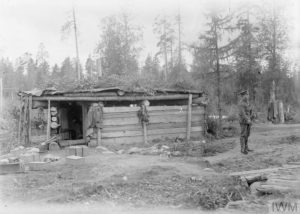Wednesday May 15th, 1918
Cleaned ammunition. Finished 9am. Very hot, washed clothes morning. Company guard night 7:30. Mail up. Two letters from home dated April 29th/18. On duty 2 till 5:30.
Company Guard
Yesterday Frank cleaned his guns and today he has cleaned the ammunition and washed his clothes. Though he doesn’t know it yet – these are all good preparations for the Battalion’s return to the front line tomorrow night.
This evening he is on company guard duty. A company guard comprises 3 or 6 soldiers under the command of a Corporal, supported by a Lance Corporal. The sentry would usually be on sentry duty for two hours and then four hours on rest.
When on the front line: ‘The soldiers would act as sentries and be responsible for raising the alarm in the event of an attack or activity in the area to his front. The Corporal in Command or his second in command would be awake at all times. The guard would be dressed and at all times be ready to react to any crisis that could develop. It would be visited by an officer whilst on duty. The guard would stand to, as would all the soldiers, an hour before dawn and an hour before sunset, this was the times that an attack was most imminent.’º
When away from the front line: ‘If the company guard was in an area from the front the role of the guard was to protect the company area, raise the alarm in case of fire and be responsible for the security, conduct and discipline of troops leaving and entering the company area if they had been out on pass or recreation.’º
Protection
Guarding positions, people and possessions is a key discipline in war time. The ‘Field Service Regulations Part I, Operations 1909’, a War Office publication, has a whole chapter on the topic, labelled ‘Protection’. The opening sentence of the chapter reads, ‘Every commander is responsible for the protection of his command against surprise. A force can only be regarded as secure from surprise when protection is furnished in every direction from which attack is possible.’¹

The manual goes on, ‘[The officer] will satisfy himself that every man knows the direction of the enemy, the position of the next piquets and of the support, what he is to do in case of attack by day or by night, whether there is any cavalry in front; that commanders of the sentry groups know what is to be done with persons who are found entering or leaving the outpost line and that sentries know in addition the positions of the sentries on their left and right, the position of the piquet and of any detached posts in the neighbourhood; the ground they have to watch; how they are to deal with persons approaching their posts; the names of all villages, rivers etc in view and the places to which roads and railroads lead.’²
Frank, on guard duty from 2am until 5:30am, hopefully knew this information.
13th (Service) Battalion War Diary – 15th May 1918 – Saida
Work on Commandant and RE parties as before. Operation Order No 37 issued (Appendix No 1). The Battalion will relieve the 9th B South Lancs Regt in No 4 Sector on the night of the 16th / 17th May 1918. The positions of the Companies this time will be D Coy on the right, C Coy centre and A Coy on the left and B Coy in reserve.
References & Further Reading
º From a thread on the Manchester.org. Specific information from Artyhughes.
¹ ‘Field Service Regulations Part I Operations 1909‘, reprinted with updates in 1912, HMSO, page 87
² as above, page 105
* Q16311, copyright Imperial War Museums


